
Carpenter Gothic, also sometimes called Carpenter's Gothic or Rural Gothic, is a North American architectural style-designation for an application of Gothic Revival architectural detailing and picturesque massing applied to wooden structures built by house-carpenters. The abundance of North American timber and the carpenter-built vernacular architectures based upon it made a picturesque improvisation upon Gothic a natural evolution. Carpenter Gothic improvises upon features that were carved in stone in authentic Gothic architecture, whether original or in more scholarly revival styles; however, in the absence of the restraining influence of genuine Gothic structures, the style was freed to improvise and emphasize charm and quaintness rather than fidelity to received models. The genre received its impetus from the publication by Alexander Jackson Davis of Rural Residences and from detailed plans and elevations in publications by Andrew Jackson Downing.
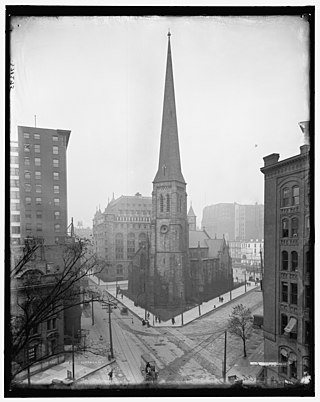
St. Paul's Cathedral is the cathedral of the Episcopal Diocese of Western New York and a landmark of downtown Buffalo, New York. The church sits on a triangular lot bounded by Church St., Pearl St., Erie St., and Main St. It was built in 1849-51 to a design by Richard Upjohn, and was believed by him to be his finest work. Its interior was gutted by fire in 1888, and was redesigned thereafter by Robert W. Gibson, and it was designated a National Historic Landmark in 1987 for its architecture.
Prairieville is an unincorporated community in Hale County, Alabama, United States.

St. Luke's Episcopal Church is a historic Carpenter Gothic church, built during the 1850s at Cahaba, the first capital of Alabama from 1820 to 1826. The unknown builder closely followed plans published by architect Richard Upjohn in his 1852 book Rural Architecture.

St. Alban's Episcopal Church is an active parish in the Episcopal Diocese of New York, in the United States. The building is an historic Carpenter Gothic style church now located at 76 St. Alban's Place in Eltingville, Staten Island. It was built in 1865 as the Church of the Holy Comforter at what is now 3939 Richmond Avenue, the present site of the South Shore YMCA, and was designed by Richard Michell Upjohn, the son of the noted Carpenter Gothic architect, Richard Upjohn. In 1873, the building was split in half and moved to its present location, where it was re-assembled and expanded. In 1951, Holy Comforter absorbed the congregation of nearby St. Anne's Episcopal Church, Great Kills, and changed its name to St. Alban's. St. Anne's had been founded in 1929 as an offshoot of Holy Comforter.
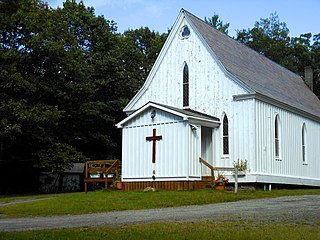
Foothills Baptist Church is an historic Carpenter Gothic church located at 2172 New York Route 22 in the Boquet section of Essex, New York, in the United States. Built in 1855 as St. John's Episcopal Church, it became the Union Church at Boquet Chapel in 1880, the Church of the Nazarene in 1949 and Foothills Baptist Church in 2005. It has also been known as Boquet Chapel.

Waldwic, also known as the William M. Spencer, III, House, is a historic Carpenter Gothic plantation house and historic district located on the west side of Alabama Highway 69, south of Gallion, Alabama. Built as the main residence and headquarters of a forced-labor farm worked by enslaved people, Waldwic is included in the Plantation Houses of the Alabama Canebrake and Their Associated Outbuildings Multiple Property Submission. The main house and plantation outbuildings were added to the National Register of Historic Places on July 22, 1994.

Faunsdale Plantation is a historic slave plantation near the town of Faunsdale, Alabama, United States. This plantation is in the Black Belt, a section of the state developed for cotton plantations. Until the U.S. Civil War, planters held as many as 186 enslaved African Americans as laborers to raise cotton as a commodity crop.
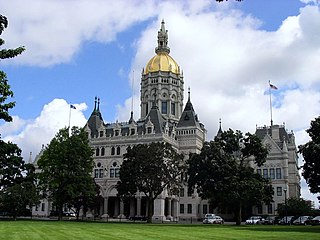
Richard Michell Upjohn, FAIA, was an American architect, co-founder and president of the American Institute of Architects.

Christ Episcopal Church, also known as Christ Church on Capitol Square, is an Episcopal church at 120 East Edenton Street in Raleigh, North Carolina. Built in 1848–53 to a design by Richard Upjohn, it is one of the first Gothic Revival churches in the American South. The church was built for a parish established in 1821; its minister is the Rev. James P. Adams. It was declared a National Historic Landmark in 1987.

Trinity Episcopal Church is a historic church in Mobile, Alabama, United States. It was the first large Gothic Revival church built in Alabama. The building was designed by architects Frank Wills and Henry Dudley.

St. Mark's Episcopal Church, now the Episcopal Parish of St. Mark and St. John, is a historic Episcopal church at 21 Race Street in Jim Thorpe, Carbon County, Pennsylvania. Completed in 1869, it is a prominent example of Gothic Revival architecture designed by that style's leading proponent, Richard Upjohn. It is one of Upjohn's last designs, and was funded by the congregation, which contained eight millionaires whose fortunes were made in the coal fields and railroad industry. It was added to the National Register of Historic Places in 1977, and declared a National Historic Landmark in 1987.
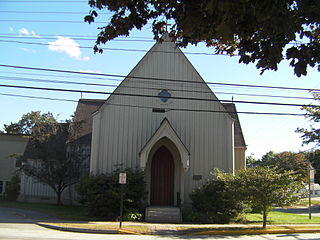
St. Paul's Episcopal Church is a historic church at 27 Pleasant Street in Brunswick, Maine. Built in 1845, it is a distinctive early example of a modest Carpenter Gothic design by Richard Upjohn, then already well known for his larger-scale Gothic churches. The building was listed on the National Register of Historic Places in 1978. The rector is Rev. Carolyn H. Eklund.

St. James' Episcopal Church is a congregation of the Episcopal Church in La Grange, Texas, under the Episcopal Diocese of Texas. Its campus at Monroe and Colorado Streets includes its historic parish church as well as a sacristy, preschool, and parish hall.

St. Stephen's Church, also known as St. Stephen's Episcopal Church, is an historic church located at 6807 Northumberland Highway, Heathsville, Northumberland County, in the Northern Neck of Virginia. Built in 1881, it was designed in the Carpenter Gothic style by T. Buckler Ghequiere. On December 28, 1979, it was added to the National Register of Historic Places. It remains in use by an active parish in the Episcopal Diocese of Virginia. It is located in the Heathsville Historic District.

St. John Chrysostom Church, also known as the Episcopal Church of St. John Chrysostom and the Little Red Church on the Hill, is a wooden Episcopal church built in 1852 in Delafield, Waukesha County, Wisconsin. In 1972 it was listed on the National Register of Historic Places.
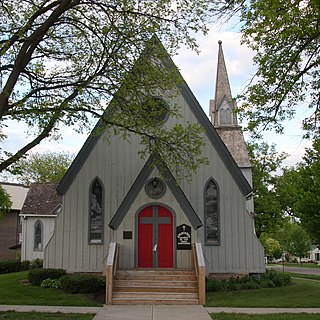
Church of the Good Shepherd Episcopal, a notable example of Rural Gothic architecture located at Moore and 8th Streets in Blue Earth, Minnesota, is the oldest surviving church building in the community. As the congregation diminished in the 1970s regular worship services were eventually suspended; in 1981 its three remaining members donated the building to the Faribault County Historical Society. Since then the church has hosted seasonal ecumenical services, Christmas concerts, weddings, and funerals. It was added to the National Register in 1980.

Henry Augustine Tayloe of Oakley Plantation, Essex County, Virginia, later Gallion, Canebrake, Alabama, was an American planter, slaveholder, horse breeder and racer, and land speculator in the 19th century.

Zion Episcopal Church is a historic Episcopal parish church founded in 1847 in Talbotton, Georgia, the county seat of Talbot County. It is a fine and unusual example of the English Tudor and carpenter-gothic style, influenced by Richard Upjohn, in a rural southern setting. The church was funded by wealthy planters from coastal Georgia and South Carolina who had created an unusually affluent community on the southern frontier by settling together in the forested piedmont of the Chattahoochee Valley –formerly remote Muscogee-Creek territory. The church today, although lacking a regular congregation, is maintained as a chapel by St. Nicholas Episcopal Church in nearby Hamilton, which hosts services in the space regularly.
Freetown is a former African American community near Gallion, in Hale County, Alabama, United States, in the so-called Canebrake region. Land and buildings formerly owned by a local slave-owning planter were left to both free and enslaved African Americans who had worked for him and lived with him, and the community lasted until the 1920s. A church built by that community in 1929 burned down in 2022.


























